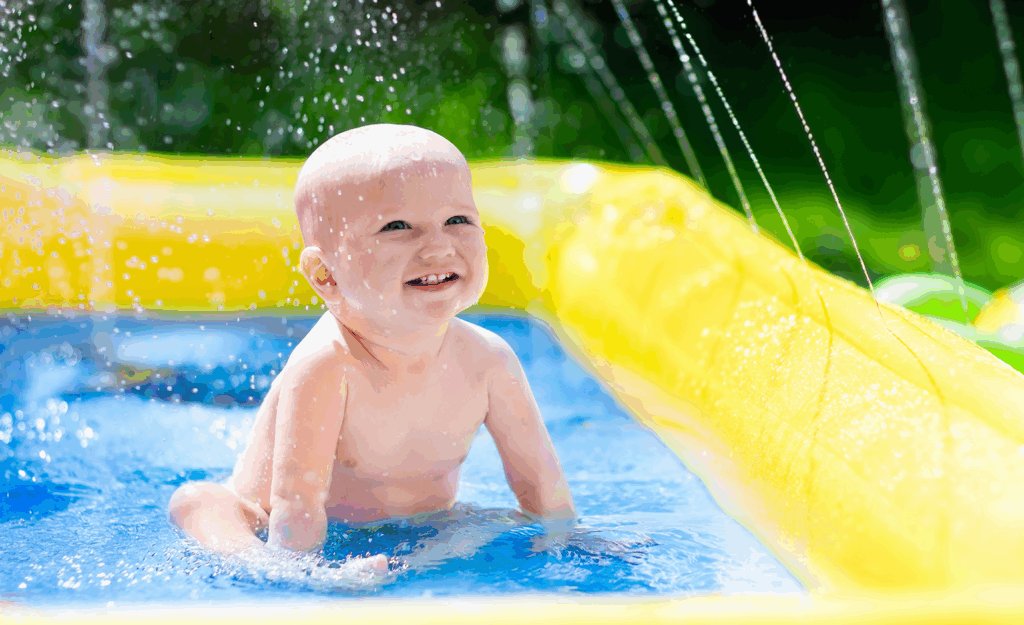A day in the sun can mean laughter, adventure and fresh air, but it also comes with risks — especially for young, sensitive skin. If you’ve ever wondered if using sunscreen on your baby is safe, you’re not alone.
Pediatricians agree sun protection is essential at every age, but how you protect your child changes as they grow. Here we will break down when babies can wear sunscreen, how to shield your child from harmful rays and what to look for in safe, effective sun products.
Why infants under 6 months should avoid sunscreen
According to the U.S. Food and Drug Administration (FDA) and the American Academy of Pediatrics (AAP), babies under 6 months old should avoid sunscreen when possible. Here’s why:
- Delicate skin absorbs more: A baby’s skin is thinner and more permeable than an adult’s, increasing the risk of irritation or allergic reactions.
- Underdeveloped sweat glands: Infants can’t regulate body temperature as easily, so sun exposure may raise their risk for heat-related illness.
- Higher absorption rates: Chemical ingredients may be absorbed into the bloodstream more easily in young infants.
For babies younger than 6 months, avoid direct sunlight altogether when possible. When you can’t avoid the sun, protect your baby with:
- A wide-brimmed hat
- Lightweight, long-sleeved clothing that covers the skin
- A breathable canopy or stroller shade
- Pop-up tents or umbrellas for outdoor time
When it’s safe to use sunscreen on babies
Once your baby turns 6 months old, most pediatricians consider it safe to use mineral-based sunscreen. These formulas sit on top of the skin, blocking UV rays rather than absorbing them.
Here’s what to look for:
- Zinc oxide or titanium dioxide as the active ingredient
- SPF 30 or higher
- Broad-spectrum sunscreen that shields against UVA and UVB rays
- Fragrance-free and hypoallergenic formulas
Avoid:
- Oxybenzone and other chemical filters
- Added fragrance or alcohol
- Spray sunscreens, which can be inhaled or unevenly applied
Before applying, test a small amount on your baby’s inner wrist or thigh. Wait 24 hours to check for redness or irritation.
Best practices for baby and toddler sun safety
When your child is mobile, having a sun safety routine is even more important. Kids love outdoor play, but their skin is still delicate and vulnerable to damage.
Protective tips for babies and toddlers:
- Dress them in long sleeves, pants and UV-blocking clothing (look for UPF-rated items).
- Use wide-brimmed hats that shade the face, neck and ears.
- Stay indoors or in full shade between 10 a.m. and 4 p.m., when UV rays are strongest.
- Apply mineral sunscreen 15 minutes before going outside. Reapply every 2 hours or after swimming or sweating.
- Use a stroller with a sunshade or portable tent during park days or beach trips.
Sunscreen guidelines for kids ages 2+
As your child grows, teaching good sun habits becomes just as important as applying sunscreen. You can expand your sunscreen options at this age, but stick with gentle, broad-spectrum products.
Look for:
- SPF 30 or higher
- Broad-spectrum protection
- Water-resistant for 40-80 minutes
- Mineral-based formulas for sensitive skin
- Easy-to-apply sticks or lotions over sprays
Applying sunscreen correctly is just as important as choosing the right sunscreen:
- Use about a shot-glass-sized amount for full body coverage
- Don’t forget easy-to-miss spots like ears, tops of feet and backs of hands
- Apply 15-30 minutes before exposure to the sun
- Reapply at least every 2 hours or after swimming/toweling off
Tips for choosing safe sunscreen products
The sunscreen aisle can be overwhelming, but knowing what to look for can make all the difference. Choose products that are:
- Labeled for babies or children
- Free of dyes, parabens or synthetic fragrances
- Tested by pediatricians or dermatologists
- Water-resistant, especially for pool or beach days
Mineral vs. chemical sunscreens:
- Mineral sunscreens (zinc oxide, titanium dioxide) reflect UV rays and are less likely to cause irritation
- Chemical sunscreens absorb UV rays but may include ingredients like oxybenzone, which some experts recommend avoiding in young children
Children with eczema or sensitive skin may benefit from sunscreens labeled “for sensitive skin” or “eczema-safe.” If you’re unsure, ask your pediatrician for a recommendation.
You don’t need to choose between outdoor fun and skin safety. Sunscreen isn’t recommended for babies under 6 months, but sun protection is still important at every age.
From finding the right SPF to knowing when to apply it, your efforts now will make an impact in preventing sunburn and reducing long-term skin cancer risk.
Not sure which sunscreen is safest for your child’s skin? Talk with your pediatrician at Mount Nittany Health for recommendations and peace of mind this summer.
Pediatrics
Discover more about Pediatrics, including locations and providers, at Mount Nittany Health



